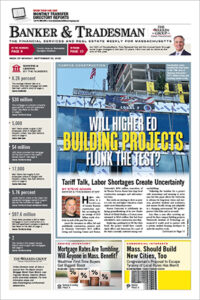
If President Donald Trump plows ahead with plans to slash federal biomedical research grants, the flow of innovations that supports Greater Boston’s life sciences industry starts to look shaky. iStock photo
Greater Boston’s reeling lab market is about to go from bad to worse.
In fact, a lot, lot worse.
The battered life sciences sector is already sitting on enough empty lab space to fill 16 Prudential towers.
Demand for new research facilities is slim to none after a massive wave of overdevelopment and subsequent retrenchment in the once red-hot life sciences sector.
Now the Trump administration is barreling ahead with plans to cut billions in National Institutes of Health grants and other funding that has gone to research powerhouses like Harvard and MIT and dozens of other institutions across the state.
At the most basic level, that will mean even fewer dollars circulating in the state’s life sciences ecosystem at a time when industry stock prices have been hammered and venture capital funding has declined.
And it couldn’t come at a worse time, with the lab vacancy rate in the Boston area poised to cross the once unthinkable 30 percent mark by year end, according to Jeffrey Meyers, research chief for the Boston office of Colliers, a commercial real estate brokerage.
16M SF Now Vacant
The Trump administration’s plans for big cuts in research funding come with conditions in the local lab market still deteriorating even after a rough couple of years.
Massachusetts potentially stands to lose nearly $3 billion in research funding, including more than $2.2 billion in money that had been earmarked for Harvard but is now frozen, according to the Massachusetts Biotechnology Council.
“I don’t think we’ve hit [bottom] yet,” Meyers said. “Whenever you are talking about the disruption of money flowing into the life sciences ecosystem, that disruption can have negative consequences.”
There are now 16 million square feet of empty lab space on the market in the Boston area, an all-time record, according to Meyers’ research.
And the amount of empty space just keeps on growing.
First there are the new lab buildings that are still under construction, having broken ground in more hopeful times.
The good news is that deluge of new space is starting to taper off.
The bad news, though, is that it still amounts to another 3 million square feet of space.
While some amount of that new space is already committed to life sciences firms, it still means that other blocks of existing lab space will become available as companies move into their new digs.
Existing Tenants Scaling Back Space
It’s not just new space that’s driving the vacancy rate skyward, but existing lab space no longer needed by companies that are scaling back and cutting jobs.
The stock prices of biotech and life sciences companies are down by roughly 50 percent from their peak.
With stock valuations down, venture capitalists have pulled back on investments in new companies, unable to see a viable exit strategy.
While overall employment in the life sciences sector has roughly held steady, there has been no growth, either, with a steady drumbeat of layoffs by a range of companies.
With less money to work with, companies have been staying put, with a big drop in potential lab tenants kicking the tires on space.
The amount of lab space sought by companies in the market dropped by more than a quarter from the fourth quarter of 2024 to the first quarter of this year, to a total of 1.5 million square feet, according to commercial brokerage Newmark’s latest quarterly report on the life sciences sector.
That’s down from 6.5 million square feet in late 2021.
More Than 60K Jobs at Risk
But that comparatively anemic demand is likely to take another, massive hit in the months and years ahead as the Trump administration slashes federal research funding.
The Bay State’s economy, while in the top 20 in the world, depends heavily on industries, like life sciences and education, that are likely to bear the brunt of the changes being pushed by the Trump administration.

Scott Van Voorhis
In a new report, Mark Williams, a Boston University Questrom School of Business master lecturer in finance, predicts the state could lose billions in revenue and tens of thousands of jobs over the next three years in life sciences and other sectors.
Not all of that would be the result of research cuts. In fact, Williams sees a bigger negative impact on the Massachusetts economy from Trump’s tariff policies.
That said, If those NIH cuts extend into 2028, they’ll wipe out somewhere between $5.4 billion and $9 billion in economic activity in Massachusetts, while erasing more than 60,000 jobs, the BU report says.
“Massachusetts risks losing its lead position in life sciences, harming an industry that has been an important economic driver,” Williams said in a statement.
As the industry goes, so goes the demand for all those millions of square feet of empty lab space.
Scott Van Voorhis is Banker & Tradesman’s columnist and publisher of the Contrarian Boston newsletter; opinions expressed are his own. He may be reached at sbvanvoorhis@hotmail.com.





